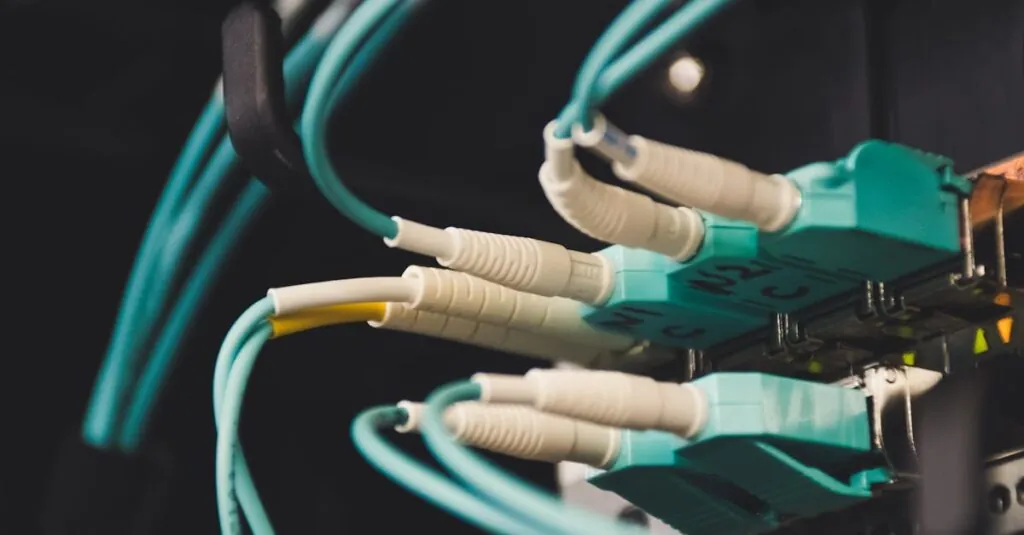Table of Contents
ToggleIn a world where buffering is the modern-day equivalent of watching paint dry, cable internet swoops in like a superhero armed with lightning-fast speeds. It’s the reliable sidekick everyone needs for binge-watching marathons, online gaming, and video calls that don’t resemble a bad sci-fi movie. With cable internet, the days of “Can you hear me now?” are long gone.
But why settle for slow connections when you can have a robust and speedy option? Cable internet combines the best of both worlds—affordable plans and high performance. Whether it’s streaming the latest blockbuster or working from home without a hitch, cable internet has got your back. So, let’s dive into the world of cable internet and discover why it’s the ultimate choice for anyone tired of frustratingly slow connections.
What Is Cable Internet?
Cable internet is a form of broadband that delivers high-speed internet through the same coaxial cables used for cable television. This technology allows for faster connections and greater bandwidth compared to DSL or dial-up services. Often, cable internet speeds reach 25 Mbps to over 1 Gbps, making it suitable for a variety of online activities.
Users enjoy cable internet for its reliability, particularly when performing data-intensive tasks like streaming and online gaming. Many households with multiple devices connected at once benefit from the consistent speed that cable provides. Additionally, cable internet often includes bundled packages that combine internet service with television and phone options, creating cost-effective solutions for consumers.
The download speeds available through cable connections make it possible to download large files in minutes. Upload speeds, however, may vary, typically reaching from 5 Mbps to 50 Mbps. Certain providers also offer higher-tier plans with even faster upload capabilities, appealing to those who require robust internet for tasks like video conferencing or large file uploads.
While cable internet is widely accessible, availability can depend on local infrastructure. Providers may differ in pricing and service offerings based on geographic location. Consumers should assess their needs and consider the options available for selecting the right cable internet provider to suit their requirements.
How Cable Internet Works
Cable internet uses coaxial cables to deliver high-speed internet. Its structure enhances performance and reliability for users engaged in heavy internet tasks.
Coaxial Cables Explained
Coaxial cables consist of a central copper conductor surrounded by insulation and a metallic shield. This design minimizes interference from external signals, ensuring a stable connection for users. Users benefit from the cable’s ability to carry high-frequency signals, which contributes to the overall speed. Data travels efficiently with minimal loss, making coaxial cables a preferred choice for internet service providers.
Signal Transmission Process
Signals travel through the coaxial cables in the form of electrical impulses. These impulses transmit data to and from the service provider’s network. Multiple channels operate simultaneously, allowing for high bandwidth use without compromising speed. Data enters into a modem that translates signals for devices. When a user accesses the internet, the modem communicates with the network, providing a seamless online experience.
Benefits of Cable Internet
Cable internet offers numerous advantages that enhance online experiences. Its combination of high speeds and wide availability attracts many users seeking reliable connections.
High Speeds and Reliability
Cable internet delivers impressive download speeds, ranging from 25 Mbps to over 1 Gbps. This speed supports data-intensive activities like binge-watching and online gaming. Reliability stands out as a crucial factor, allowing seamless video calls and smooth streaming without interruptions. Users commonly notice the ability to connect multiple devices simultaneously without sacrificing performance. Overall, users find cable internet ideal for homes with high-bandwidth demands, ensuring consistent service.
Wide Availability
Cable internet is widely available across various regions, reaching many urban and suburban areas. More than 90% of American households can access cable internet, making it a preferred choice for many. Local infrastructure often determines availability, but providers continuously expand their coverage. Consumers easily identify options by checking service maps from major cable companies. Additionally, bundled packages frequently include television and phone services, further enhancing cost-effectiveness. Users appreciate the convenience of bundled services, simplifying their internet and entertainment needs.
Limitations of Cable Internet
Cable internet exhibits some significant limitations that users should consider.
Potential for Congestion
Congestion occurs when many users share the same bandwidth. This scenario often arises during peak usage hours, resulting in slower speeds for everyone connected. Neighborhoods connected to the same infrastructure may experience dips in performance, affecting streaming and gaming. Subscribers might notice buffering or lag when multiple devices use the internet simultaneously. Providers often struggle to alleviate this issue, especially in densely populated areas. Evaluating local user density can provide insights into potential congestion challenges.
Equipment Costs
Equipment costs for cable internet vary based on the provider and subscription plan. A cable modem is essential for accessing the internet, and purchasing or renting one incurs additional expenses. Renters may face monthly fees, while buyers incur a one-time upfront cost, leading to decisions based on long-term usage. The need for a compatible router adds further costs, especially for those requiring advanced features such as enhanced Wi-Fi coverage. Subscribers must factor these costs into their overall budgeting for internet needs.
Comparing Cable Internet to Other Options
Cable internet stands out among various internet options due to its unique features.
DSL and Fiber Optic Internet
DSL internet delivers slower speeds than cable, often ranging from 1 Mbps to 100 Mbps. Fiber optic internet, on the other hand, offers faster speeds, typically from 100 Mbps to over 1 Gbps, and supports higher data capacities. While fiber can outperform cable in speed, its availability is limited to certain areas, leaving many consumers relying on cable. Upload speeds with cable tend to be lower than fiber, which can impact users needing robust upload capabilities. Nevertheless, cable internet remains more readily available across urban and suburban regions compared to fiber, reaching over 90% of American households.
Mobile Hotspots
Mobile hotspots provide internet access via cellular networks, allowing flexibility for users on the go. Speeds for mobile hotspots can vary widely, ranging from 3 Mbps to 50 Mbps, influenced by network conditions. While convenient, mobile hotspots may experience data limits, unlike cable internet, which typically offers more consistent usage without caps. Overall, cable internet tends to deliver a more stable connection and higher speeds, making it a preferred choice for home use, particularly for streaming and gaming requirements.
Conclusion
Cable internet stands out as a reliable and high-speed option for users seeking seamless online experiences. Its impressive download speeds and wide availability make it a go-to choice for activities like streaming and gaming. While there are some limitations such as potential congestion during peak hours and equipment costs, the overall performance often outweighs these concerns.
For those looking for a stable connection that supports multiple devices without interruption, cable internet remains a strong contender. With bundled packages that simplify entertainment needs, it offers both convenience and value. As consumers evaluate their internet options, cable internet continues to prove itself as a solid solution in the ever-evolving digital landscape.





